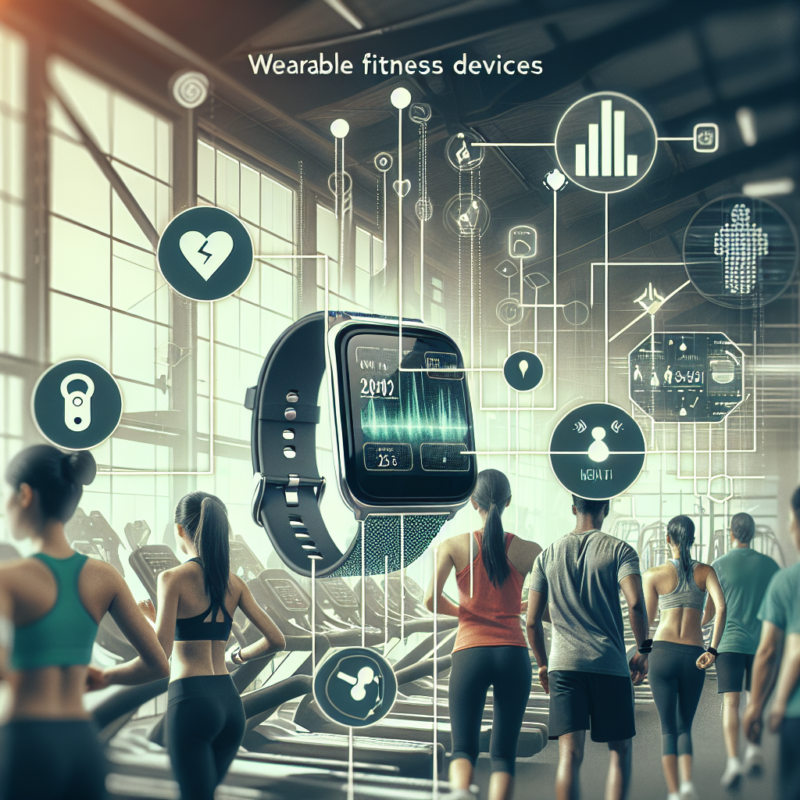The landscape of the health and fitness industry is undergoing a significant transformation, primarily driven by the advent of wearable fitness technology. These devices, ranging from smartwatches to fitness trackers, have changed the way individuals approach physical activity, nutrition, and overall wellness. As the demand for personal health management rises, understanding the impact of wearable fitness technology is vital for both consumers and industry professionals. This article delves into the multifaceted effects of these innovative tools on the health and fitness industry, exploring their advantages, challenges, and future prospects.
Section 1: Revolutionizing Personal Health Monitoring
Wearable fitness technology has revolutionized personal health monitoring by providing users with real-time data about their physical activity, heart rate, sleep patterns, and more. Unlike traditional methods, wearables enable individuals to track their progress continuously, fostering a proactive approach to health and fitness. This data is not just numbers but actionable insights that motivate users to set personal goals, monitor their progress, and make informed lifestyle choices. Furthermore, with the integration of mobile applications, users can easily visualize their data trends, adding another layer of engagement and personalization to their fitness journey.
The widespread adoption of wearable technology has also empowered individuals to take control of their health. For instance, heart rate monitors and pedometers have made it easier to understand personal fitness levels and capabilities. As more people wear these devices, collective health data becomes increasingly valuable, with potential implications for public health trends. Wearable fitness technology also enables professionals in the health and fitness industry to tailor programs to individual needs, enhancing the overall efficacy of fitness training and health interventions.
Section 2: Enhancing Engagement in Fitness Routines
Another impactful aspect of wearable fitness technology is its ability to enhance user engagement in fitness routines. Features such as goal setting, reminders, and performance tracking motivate users to remain consistent and dedicated to their fitness objectives. For many, gamification elements such as challenges, badges, and leaderboards create a sense of community and competition, which can drive users to push their limits. This sense of achievement doesn’t just benefit individual users; it can also create a ripple effect, encouraging friends and family to join in on fitness activities.
The engagement fostered by wearables can also lead to improved adherence to exercise programs. Studies have shown that wearables can significantly increase physical activity levels among users, as they provide constant feedback and encouragement. Fitness trainers and coaches can leverage this technology to monitor their clients’ activity levels closely, enabling them to make timely adjustments for optimal results. Such integration between wearables and personalized coaching is essential for helping individuals reach their maximum potential.
Section 3: Transforming Data into Health Insights
The data generated by wearable fitness technology provides invaluable insights that can transform personal health management. Data such as heart rate variability, calorie expenditure, and sleep quality can help users identify patterns and areas for improvement in their health and fitness regimens. By conducting longitudinal tracking, users can gain a deeper understanding of how various factors affect their performance, leading to more informed lifestyle choices. For instance, recognizing the correlation between poor sleep and subpar workout performance can motivate users to prioritize rest and recovery, crucial components of any fitness program.
Beyond individual insights, the aggregated data from wearables can benefit the health and fitness industry at large. Fitness companies and health organizations can analyze trends to develop more effective programs, apps, and products tailored to consumer needs. This data-driven approach not only optimizes resource allocation but also enhances customer engagement strategies. Ultimately, these insights empower health professionals to offer more personalized guidance, fostering better health outcomes for their clients.
The potential for AI and machine learning to further revolutionize data interpretation is significant. As wearables become increasingly sophisticated, algorithms can analyze user data to predict health risks, recommend interventions, and provide personalized wellness insights. This evolution in data utilization represents the next frontier in health and fitness, opening doors to preventive healthcare and more efficient treatment models.
Section 4: Challenges and Limitations of Wearable Technology
Despite the substantial advantages of wearable fitness technology, several challenges and limitations need addressing. One of the most pressing concerns is data privacy. Users must share sensitive health data with device manufacturers and apps, raising issues about how this data is stored, shared, and protected. In an era where data breaches are commonplace, ensuring user privacy is paramount for building trust and encouraging widespread adoption of wearable technology.
Another critical challenge is the accuracy and reliability of the data collected by wearables. While many devices offer advanced tracking capabilities, not all wearables are created equal. Variability in sensor technology can lead to discrepancies in measurements, which may mislead users about their health metrics. Inconsistent data can undermine the value of wearables, causing frustration among users and potentially leading to poor health decisions.
Lastly, there is a risk of over-reliance on technology. While wearables can provide valuable insights and motivation, they cannot replace the advice and expertise of health and fitness professionals. Users may become passive recipients of data, relying solely on their devices rather than existing knowledge and experience. Striking a balance between utilizing technology and seeking professional guidance is essential for achieving the best health outcomes.
Section 5: The Future of Wearable Fitness Technology
The future of wearable fitness technology looks promising, with ongoing advancements set to further enhance the user experience and efficacy of these devices. Innovations such as more sophisticated biometric sensors and AI-driven algorithms will likely enable deeper insights into individual health metrics and performance. The emergence of smart textiles, which integrate sensors into clothing, promises to make health monitoring even more seamless and user-friendly. This evolution will lead to even greater adoption rates across diverse demographics.
Moreover, collaborations between tech companies and healthcare providers are likely to spur the growth of more integrated health solutions. As the health and fitness industry increasingly embraces telehealth and digital health tools, wearables can play a pivotal role in monitoring patients’ progress remotely. This integration will not only optimize healthcare delivery but also foster preventive healthcare practices, creating a healthier society overall.
Finally, as consumer awareness of health and fitness rises, the demand for customizable and comprehensive health solutions will grow. Wearable technology will need to evolve to meet diverse user needs, from casual gym-goers to elite athletes. This adaptability will enable wearables to maintain their relevance in the ever-changing landscape of the health and fitness industry, continuing to empower users in their wellness journeys.
Conclusion
In conclusion, wearable fitness technology has significantly impacted the health and fitness industry by revolutionizing personal health monitoring, enhancing engagement in fitness routines, and providing transformative insights through data analysis. While challenges concerning data privacy and accuracy remain, the future of wearable technology holds great promise, driven by ongoing innovations and increased integration with healthcare. As wearables continue to evolve, they will undoubtedly play an essential role in shaping how individuals and professionals approach health and fitness, fostering a culture of wellness and proactive health management.
FAQs
What types of wearable fitness technology are available?
Wearable fitness technology encompasses a variety of devices, including fitness trackers, smartwatches, smart clothing, and heart rate monitors. Each type offers different functionality to assist users in monitoring their health and fitness levels.
How can wearable technology improve my fitness?
Wearable technology can enhance your fitness by providing real-time feedback on your physical activity, tracking your progress, and helping you set and achieve fitness goals. It can also foster motivation through gamification and community features.
What are the privacy concerns associated with wearable fitness technology?
Privacy concerns related to wearable technology arise from the sensitive health data that users must share with device manufacturers and apps. Users should be aware of how their data is stored, shared, and potentially sold to third parties.
Are wearable fitness devices accurate?
While many wearable fitness devices provide valuable insights, their accuracy can vary based on the technology used. Users should consider using multiple data sources and consult with professionals for a holistic understanding of their health metrics.
Can wearable fitness technology replace personal trainers?
Wearable fitness technology can complement personal trainers but cannot replace their expertise. They provide valuable feedback and motivation but can lack the personalized guidance and tailored programming that a trainer offers.
This comprehensive article covers the impact of wearable fitness technology on the health and fitness industry, structured with relevant headings and formatted accordingly for SEO optimization.





